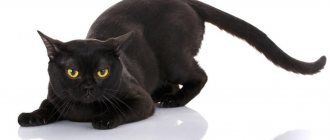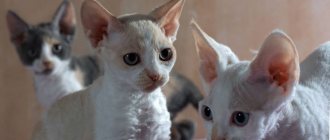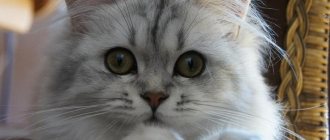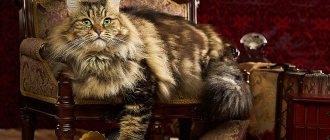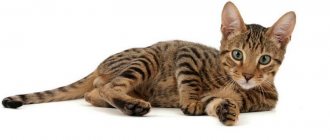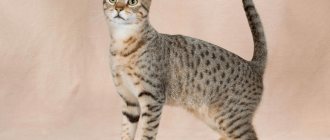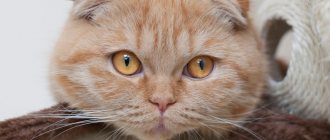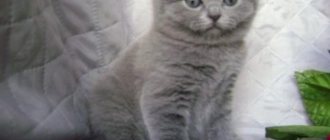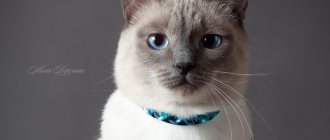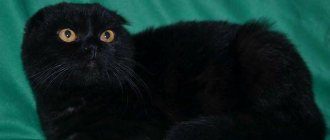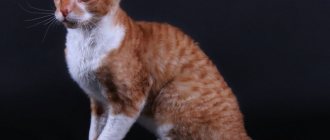Home » Breeds » About the Celtic cat breed
It would seem like an ordinary, well-known domestic cat, nothing remarkable. But in fact, the Celts have excellent hunting instincts and a strong sense of self-esteem. They also have two names: Celtic and European shorthair. Why is that? Let's figure it out.
Origin story
Once upon a time there were yard cats in the world. They lived a very long time ago, crawled through garbage dumps in search of food, and caught rodents.
The smartest or luckiest sometimes ended up in human dwellings and continued to exist there, trying to repay food and shelter by killing mice and being smart.
Centuries passed, and yard cats hardly changed, either in appearance or in character. Independent animals perfectly adapted to the harsh conditions of survival on the street and were not very eager to be domesticated.
Breeders became interested in this independence, and by the end of the 20th century they developed a new breed, using as a basis yard cats - excellent hunters, famous for their unpretentiousness.
Character traits
Cats are completely independent and independent, capable of getting their own food.
The Celtic cat is a completely independent and independent creature. He is not capricious, knows his own worth and will not tolerate insults from his own owners, for this reason communication is preferred only with those family members who love and respect him. The cat chooses its favorite and shows tenderness, affection and love towards it. The animal always relies on itself, even if the owner forgets to feed, he will try to open the refrigerator, take food from the table, or begin to catch insects that fly into the apartment.
The Celtic cat breed is silent; they rarely speak. An animal can meow only in extreme situations, for example, if you step on its tail or the owner begins the bathing process. They find it difficult to get along with other pets and do not like sharing care and love with them. They make contact with small children without much pleasure, they try to hide and not show themselves.
Interesting Facts
The development of a new breed began almost simultaneously in Norway, Denmark and Sweden. A little later, England, Germany, and France joined this process.
And if the first three got a Celtic or Swedish domestic cat (in Sweden), then the second three called their creation a European (or British) shorthair cat. France went even further and gave its pets the name “chartreuse”.
Later, the United States got involved and developed its own breed, calling it the American Shorthair cat.
The confusion over the names was ended in 1982, when the breed standard was recognized and the name “Celtic” or “European Shorthair” was established.
The breed is not particularly popular among followers of fashionable cats, as it has the most ordinary appearance and independent character, which it will not fail to show to its owner.
But for connoisseurs of simplicity and reliability, these animals are simply irreplaceable.
A photo of a Celtic cat is practically no different from a photo of a simple street cat.
Nutritional Features
If an animal eats dry food, it is recommended to dilute its diet with natural food.
These animals are unpretentious in food. After birth, small kittens are fed dairy products 5-6 times a day. Already grown children are transferred to 2-3 meals a day. Cats like dry food, especially super and premium food. Such a diet must be diluted with natural food. The Celtic cat needs daily consumption of such foods as:
- boiled meat;
- fish products;
- vegetables, boiled or steamed;
- chicken eggs, which it is advisable to give no more than 2 times a week;
- milk porridge;
- fermented milk products, except milk.
Caring for a European cat
An animal of this breed does not require special care. The cat will wash smooth fur on its own, and tangles will not form, since the fur is too short for this. If desired, the cat can be brushed periodically, but this is not necessary.
The cat has good health and strong immunity.
How to care
When describing the care of a representative of the Celtic cat breed, it is better to say briefly - this breed is “for the lazy.” There is practically no need to comb the skin.
Note!
Singapore cat: character, photo, price, breed description, reviews, how to buy, how to choose, maintenance, care and owner reviews
Scottish Straight: cat photo, kitten prices, breed description, character, reviews, maintenance and care, nutrition + interesting facts
Chausie - overview of the breed, character and breeding characteristics. Price for a kitten and tips for choosing a purebred cat (115 photos)
Bathing - well, if only once a year. Maybe even two. This is more than enough. With frequent water treatments, the skin may lose its shine.
The health of your pet also does not require any effort. However, experts insist on at least a minimum of vaccinations. But Celts rarely get sick, and this breed has no hereditary diseases at all.
They are completely undemanding when it comes to food. Like good hunters, they perfectly catch small rodents and birds. They can eat them too, but they prefer boiled meat to raw meat.
Like any cats, Celts are big fish lovers; they value milk, cottage cheese, and boiled eggs. They won’t refuse a vegetable side dish.
But it is better not to give them fatty foods, as well as smoked sausages. Such dishes will not be healthy for any cat (and for humans, so why be silent?). There should be at least a third of meat products in the diet, preferably half.
Celtic cat price
The cost of kittens depends on their pedigree and varies from 5,000 to 30,000 rubles. However, you need to be especially vigilant with this breed - instead of a purebred animal, you can easily buy an ordinary yard Murzik. In principle, no one will notice the difference.
The Celtic cat is a rather rare breed for Russia; not all breeders breed it, and to the question “Where to buy a Celtic cat” it is better to look for the answer on the Internet or check with any cat club.
Appearance
The Celtic breed has pronounced sexual dimorphism. Depending on the gender, the weight of cats ranges from 4 to 8 kg.
According to the approved standard, purebred representatives have:
- wide-set ears, rounded at the tips (tassels are allowed);
- large, rounded head with developed cheeks and a strong chin;
- rounded eyes, characterized by uniform color of the iris (amber, green and blue shades, as well as heterochromia, are acceptable);
- a distinct stop, characterized by a slight depression between the eyes;
- flexible body with developed muscles and a rounded chest;
- strong and strong paws, tapering at the base;
- tail of medium length with a rounded narrow tip and a wide base.
The Celts have a short and thick coat, distinguished by the shine and elasticity of the hairs.
The standard allows any colors except:
- chocolate;
- acromelanic (Siamese);
- lilac;
- cinnamon (red-brown).
- faun.
All of the listed colors are a consequence of mixing with other breeds, which is strictly prohibited.
Photo of a Celtic cat
Read here Where to start betting
Help the site, share with friends 
Health status and vaccination against diseases
The average lifespan of a Celt is 15-20 years. Representatives have excellent health and their bodies are not susceptible to diseases that are inherited. Over the course of a long time, the immune system of a European cat has been hardened by street life. The main danger for animals is infectious disease. The first vaccinations according to the vaccination schedule are given to kittens after 8-10 weeks of birth. A week before vaccination, helminthization of the cat is considered a prerequisite.
Kittens
A kitten of the European breed will be an ideal gift for your child. Special charm, a constant desire to play and move, irrepressible energy and friendliness - these are the very qualities that make European kittens the closest friends for kids and distinguish them from others. In addition, their unpretentiousness and developed intelligence somewhat reduce the minimum age at which a kitten can be purchased - this is 2.5–3 months.
In any case, they quickly get used to their new home and become attached to all family members. Once you look at these cute little lumps, you will always be captivated by their charm.
Breeders are constantly working to preserve and maintain the high breeding level of this breed. This is one of the main areas of work of each nursery, along with constant participation in exhibitions and shows.
We present to your attention photos of kittens of various colors, for a general idea about these cats.
If you decide to buy yourself a smooth-haired kitten of the European breed, look for a club that specializes in these cats.
The final price of a kitten in each nursery, as a rule, is negotiated separately, so you can choose a baby for yourself in accordance with your financial capabilities.
